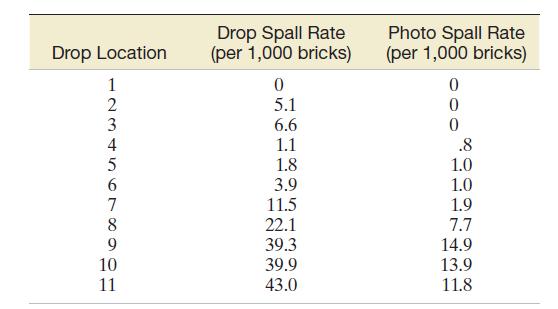Spall damage in bricks. A recent civil suit revolved around a five-building brick apartment complex located in
Question:
Spall damage in bricks. A recent civil suit revolved around a five-building brick apartment complex located in the Bronx, New York, which began to suffer spalling damage
(i.e., a separation of some portion of the face of a brick from its body). The owner of the complex alleged that the bricks were manufactured defectively. The brick manufacturer countered that poor design and shoddy management led to the damage. To settle the suit, an estimate of the rate of damage per 1,000 bricks, called the spall rate, was required (Chance, Summer 1994). The owner estimated the spall rate by using several scaffold-drop surveys. (With this method, an engineer lowers a scaffold down at selected places on building walls and counts the number of visible spalls for every 1,000 bricks in the observation area.) The brick manufacturer conducted its own survey by dividing the walls of the complex into 83 wall segments and taking a photograph of each one. (The number of spalled bricks that could be made out from each photo was recorded, and the sum over all 83 wall segments was used as an estimate of total spall damage.)
In this court case, the jury was faced with the following dilemma: On the one hand, the scaffold-drop survey provided the most accurate estimate of spall rates in a given wall segment. Unfortunately, however, the drop areas were not selected at random from the entire complex;
rather, drops were made at areas with high spall concentrations, leading to an overestimate of the total damage.
On the other hand, the photo survey was complete in that all 83 wall segments in the complex were checked for spall damage. But the spall rate estimated by the photos, at least in areas of high spall concentration, was biased low (spalling damage cannot always be seen from a photo), leading to an underestimate of the total damage.
The data in the table are the spall rates obtained from the two methods at 11 drop locations. Use the data, as did expert statisticians who testified in the case, to help the jury estimate the true spall rate at a given wall segment.
Then explain how this information, coupled with the data (not given here) on all 83 wall segments, can provide a reasonable estimate of the total spall damage (i.e., total number of damaged bricks).
Step by Step Answer:

Statistics Plus New Mylab Statistics With Pearson Etext Access Card Package
ISBN: 978-0134090436
13th Edition
Authors: James Mcclave ,Terry Sincich






